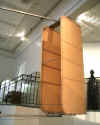
Let's begin with a walk around the plane. This is
what greets you when you enter Wright Hall. |

Move to your right and begin to walk around the pit.
The wooden box is the Wright's Huffman Prairie tool chest. |

If you could descend the stairs into the pit, here's
how the Flyer looks at eye level. |

Looking at the aircraft from the side -- this is
what Will and Orv saw when they ran beside it on take-off. |

Continuing around, here's a diagonal view from the
rear. |

Further along, you get a good overview of the
cockpit. |

Here's the Flyer from the rear, looking forward. |

Another diagonal view. We're almost back to
where we started. |

Down in the pit, here's what the cockpit looks like
up close. |

All the flight instruments are at Orville's right
elbow -- anemometer, stopwatch, fuel shut-off. |

A view of the engine from the front. There is no
muffler. |

At the rear of the engine is a flywheel and the
drive sprockets. |

The pilot hooks his toes over this foot rest. There
is no safety belt. |

A chain runs from the engine to each propeller. |

The chain runs over a large sprocket on the
propeller shaft. |

The propeller is bolted to the shaft. It's also
screwed from the back. |

To keep the props from splintering, the ends are
covered with canvas. |

Note that the chain guide tubes are bent where the
chain crosses over itself. |

The Wrights added "blinkers" to the canard
to keep the aircraft's nose up in a turn. |

The elevator control varies the camber of the canard
as you move it. |

The elevator frame is bolted to the front skid to
make the aircraft easy to disassemble. |

The strut fittings are actually hinges that allow
the wings to warp. |

When the control cables pass through pulleys, the
Wrights inserted a bit of chain. |

The rudder is attached to the flyer with just two long
beams and bracing wires. |
![]()
![]()